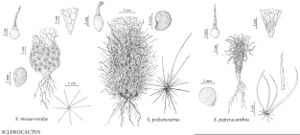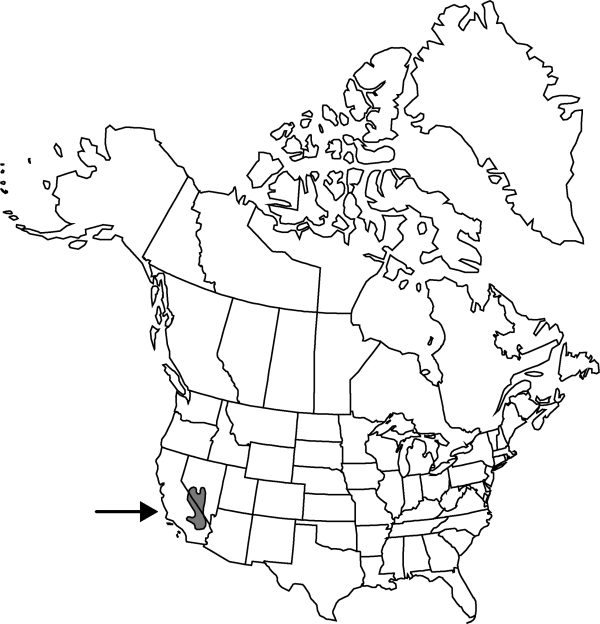Difference between revisions of "Sclerocactus polyancistrus"
Cact. 3: 213. 1922.
FNA>Volume Importer |
imported>Volume Importer |
||
| (7 intermediate revisions by 2 users not shown) | |||
| Line 8: | Line 8: | ||
}} | }} | ||
|common_names=Mojave eagle-claw cactus;hermit cactus;pineapple cactus;red-spined fishhook cactus | |common_names=Mojave eagle-claw cactus;hermit cactus;pineapple cactus;red-spined fishhook cactus | ||
| − | |basionyms={{Treatment/ID/ | + | |special_status={{Treatment/ID/Special_status |
| + | |code=F | ||
| + | |label=Illustrated | ||
| + | }}{{Treatment/ID/Special_status | ||
| + | |code=E | ||
| + | |label=Endemic | ||
| + | }} | ||
| + | |basionyms={{Treatment/ID/Basionym | ||
|name=Echinocactus polyancistrus | |name=Echinocactus polyancistrus | ||
|authority=Engelmann & J. M. Bigelow | |authority=Engelmann & J. M. Bigelow | ||
| + | |rank=species | ||
| + | |publication_title=Proc. Amer. Acad. Arts | ||
| + | |publication_place=3: 272. 1856 | ||
}} | }} | ||
|synonyms={{Treatment/ID/Synonym | |synonyms={{Treatment/ID/Synonym | ||
|name=Ferocactus polyancistrus | |name=Ferocactus polyancistrus | ||
|authority=(Engelmann & J. M. Bigelow) N. P. Taylor | |authority=(Engelmann & J. M. Bigelow) N. P. Taylor | ||
| − | }}{{Treatment/ID/Synonym | + | |rank=species |
| + | }} {{Treatment/ID/Synonym | ||
|name=Pediocactus polyancistrus | |name=Pediocactus polyancistrus | ||
|authority=(Engelmann & J. M. Bigelow) G. Arp | |authority=(Engelmann & J. M. Bigelow) G. Arp | ||
| + | |rank=species | ||
}} | }} | ||
|hierarchy=Cactaceae;Cactaceae subfam. Cactoideae;Sclerocactus;Sclerocactus polyancistrus | |hierarchy=Cactaceae;Cactaceae subfam. Cactoideae;Sclerocactus;Sclerocactus polyancistrus | ||
| Line 26: | Line 38: | ||
}}<!-- | }}<!-- | ||
| − | --><span class="statement" id="st- | + | --><span class="statement" id="st-undefined" data-properties=""><b>Stems </b>unbranched or in clusters, cylindric or elongate cylindric, 10–40(–45) × 5–9 cm; ribs 13–17, well developed, tubercles not evident on ribs. <b>Spines</b> dense, obscuring stems; radial spines 10–15(–18) per areole, white, straight, flat, 20–50 mm, glabrous; central spines 9–12 per areole, 5–8 hooked, others straight, terete to angled; abaxial and lateral central spines 6–8 per areole, red or reddish brown (rarely yellow), some hooked, (30–)56–100 × 0.7–1.2 mm; adaxial central spines usually 3 per areole, white, usually curved or twisted, flat, usually 37–86(–130) × 1.7–3.4 mm. <b>Flowers</b> with spicy, pungent odor, funnelform, 5–10 × 5–9 cm; outer tepals with greenish purple midstripes and rose-purple or magenta margins, cuneate-spatulate, usually 15–30 × 6–9 mm; inner tepals rose-purple to magenta (rarely white), largest tepals ovate-lanceolate, 24–45 × 9–12 mm; filaments greenish yellow; anthers cream; style grooved, not papillate. <b>Fruits</b> irregularly dehiscent at base, green, tan, or red, barrel-shaped, 22–50 × 12–25 mm, dry at maturity; scales few, white fringed. <b>Seeds</b> black, 2.7–3.7 × 2–2.5 mm, shiny; testa with fine, rounded papillae.</span><!-- |
-->{{Treatment/Body | -->{{Treatment/Body | ||
| + | |phenology=Flowering Apr–Jun. | ||
|habitat=Rocky alluvial, often alkaline soils, Mojave desert scrub | |habitat=Rocky alluvial, often alkaline soils, Mojave desert scrub | ||
|elevation=500-2500 m | |elevation=500-2500 m | ||
|distribution=Calif.;Nev. | |distribution=Calif.;Nev. | ||
| − | |discussion=<p>Sclerocactus polyancistrus is the only member of the genus that truly lacks papillae on the style, and its style possesses grooves, somewhat reminiscent of Ferocactus. It is easily recognized by its massive stem size (relative to other species of Sclerocactus), large flowers, and numerous hooked central spines (five to nine).</p> | + | |discussion=<p><i>Sclerocactus polyancistrus</i> is the only member of the genus that truly lacks papillae on the style, and its style possesses grooves, somewhat reminiscent of <i>Ferocactus</i>. It is easily recognized by its massive stem size (relative to other species of <i>Sclerocactus</i>), large flowers, and numerous hooked central spines (five to nine).</p> |
|tables= | |tables= | ||
|references= | |references= | ||
| Line 41: | Line 54: | ||
-->{{#Taxon: | -->{{#Taxon: | ||
name=Sclerocactus polyancistrus | name=Sclerocactus polyancistrus | ||
| − | |||
|authority=(Engelmann & J. M. Bigelow) Britton & Rose | |authority=(Engelmann & J. M. Bigelow) Britton & Rose | ||
|rank=species | |rank=species | ||
| Line 48: | Line 60: | ||
|basionyms=Echinocactus polyancistrus | |basionyms=Echinocactus polyancistrus | ||
|family=Cactaceae | |family=Cactaceae | ||
| + | |phenology=Flowering Apr–Jun. | ||
|habitat=Rocky alluvial, often alkaline soils, Mojave desert scrub | |habitat=Rocky alluvial, often alkaline soils, Mojave desert scrub | ||
|elevation=500-2500 m | |elevation=500-2500 m | ||
| Line 54: | Line 67: | ||
|publication title=Cact. | |publication title=Cact. | ||
|publication year=1922 | |publication year=1922 | ||
| − | |special status= | + | |special status=Illustrated;Endemic |
| − | |source xml=https:// | + | |source xml=https://bitbucket.org/aafc-mbb/fna-data-curation/src/2e0870ddd59836b60bcf96646a41e87ea5a5943a/coarse_grained_fna_xml/V4/V4_384.xml |
|subfamily=Cactaceae subfam. Cactoideae | |subfamily=Cactaceae subfam. Cactoideae | ||
|genus=Sclerocactus | |genus=Sclerocactus | ||
|species=Sclerocactus polyancistrus | |species=Sclerocactus polyancistrus | ||
| − | |||
| − | |||
| − | |||
| − | |||
| − | |||
| − | |||
| − | |||
| − | |||
| − | |||
| − | |||
| − | |||
| − | |||
| − | |||
| − | |||
| − | |||
| − | |||
| − | |||
| − | |||
| − | |||
| − | |||
| − | |||
| − | |||
| − | |||
| − | |||
| − | |||
| − | |||
| − | |||
| − | |||
| − | |||
| − | |||
| − | |||
| − | |||
| − | |||
| − | |||
| − | |||
| − | |||
| − | |||
| − | |||
| − | |||
| − | |||
| − | |||
| − | |||
| − | |||
| − | |||
| − | |||
| − | |||
| − | |||
| − | |||
| − | |||
| − | |||
| − | |||
| − | |||
| − | |||
| − | |||
| − | |||
| − | |||
| − | |||
| − | |||
| − | |||
| − | |||
| − | |||
| − | |||
| − | |||
| − | |||
| − | |||
| − | |||
| − | |||
}}<!-- | }}<!-- | ||
-->[[Category:Treatment]][[Category:Sclerocactus]] | -->[[Category:Treatment]][[Category:Sclerocactus]] | ||
Latest revision as of 21:58, 5 November 2020
Stems unbranched or in clusters, cylindric or elongate cylindric, 10–40(–45) × 5–9 cm; ribs 13–17, well developed, tubercles not evident on ribs. Spines dense, obscuring stems; radial spines 10–15(–18) per areole, white, straight, flat, 20–50 mm, glabrous; central spines 9–12 per areole, 5–8 hooked, others straight, terete to angled; abaxial and lateral central spines 6–8 per areole, red or reddish brown (rarely yellow), some hooked, (30–)56–100 × 0.7–1.2 mm; adaxial central spines usually 3 per areole, white, usually curved or twisted, flat, usually 37–86(–130) × 1.7–3.4 mm. Flowers with spicy, pungent odor, funnelform, 5–10 × 5–9 cm; outer tepals with greenish purple midstripes and rose-purple or magenta margins, cuneate-spatulate, usually 15–30 × 6–9 mm; inner tepals rose-purple to magenta (rarely white), largest tepals ovate-lanceolate, 24–45 × 9–12 mm; filaments greenish yellow; anthers cream; style grooved, not papillate. Fruits irregularly dehiscent at base, green, tan, or red, barrel-shaped, 22–50 × 12–25 mm, dry at maturity; scales few, white fringed. Seeds black, 2.7–3.7 × 2–2.5 mm, shiny; testa with fine, rounded papillae.
Phenology: Flowering Apr–Jun.
Habitat: Rocky alluvial, often alkaline soils, Mojave desert scrub
Elevation: 500-2500 m
Discussion
Sclerocactus polyancistrus is the only member of the genus that truly lacks papillae on the style, and its style possesses grooves, somewhat reminiscent of Ferocactus. It is easily recognized by its massive stem size (relative to other species of Sclerocactus), large flowers, and numerous hooked central spines (five to nine).
Selected References
None.

